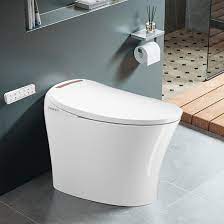What is a Smart Toilet?
If you’re not familiar with smart toilets, they are a modern upgrade to traditional toilets. A smart toilet is a toilet that has advanced features such as automatic flush, seat warming, bidet, deodorizing, and even speakers that play music or respond to voice commands. Smart toilets come with tiny computers that process the commands and operate the features. Unlike the traditional toilets, smart toilets require electricity to function.
How do Smart Toilets Work?
Smart toilets have control panels that allow the user to customize their experience. The control panels can be remote or on the toilet itself. Different smart toilets have different features, but they all work in a similar way. They have a computer-controlled mechanism that opens the lid when you approach, flushes automatically after use, and cleans the bowl. The bidet feature sprays a precise amount of water to clean you off. Some toilets have air dryers and heated seats that warm up within seconds of sitting on them.
Do Smart Toilets Need Electrical Power?
Yes, smart toilets need electrical power to operate the advanced features that come with them. Most toilets come with an electrical cord that you can plug into a standard 220V outlet. If you don’t have an electrical outlet near your toilet, you can hire an electrician to install one in the bathroom. Some models don’t need a direct electrical connection, but they run on batteries instead. However, the batteries need to be replaced periodically to keep the toilet working properly.
How to Install a Smart Toilet?
Smart toilets have a similar installation process to traditional toilets. You need to have a water connection (hot and cold), a sewage drain, and an electrical outlet in the bathroom. Since smart toilets are heavier than regular toilets, you need to make sure that the floor can support the weight. If you’re considering installing a smart toilet, it’s best to hire a professional plumber to ensure that all the connections are set up correctly.
Types of Smart Toilets
There are many types of smart toilets available. Some of the most popular ones are:
- Wall-mounted smart toilets: these toilets save space and give the bathroom a minimalist look.
- Integrated smart toilets: these toilets come with a built-in bidet, seat warmer, and deodorizer.
- Heated smart toilets: these toilets have a heating system that warms the seat and water.
- Voice-activated smart toilets: these toilets respond to voice commands and can do things like play music or change the lighting in the bathroom.
Benefits of Smart Toilets
Smart toilets have many benefits, such as:
- They are more hygienic than traditional toilets because they are self-cleaning.
- They have adjustable water pressure to make the cleaning process more comfortable.
- They save water because they use less water than traditional toilets.
- They can reduce the use of toilet paper, which is eco-friendly.
- They offer a more comfortable experience because of the heated seat and adjustable water temperature.
Smart Toilets and the Environment
Smart toilets are more eco-friendly than traditional toilets. They save water because they only use as much water as needed. They also reduce the use of toilet paper, which is beneficial for the environment. Smart toilets are designed with the environment in mind, and they are an excellent investment for anyone who wants to reduce their carbon footprint.
The Cost of Smart Toilets
Smart toilets are more expensive than traditional toilets because of the advanced features they offer. The cost of a smart toilet can range from $800-$5000 depending on the brand and features. Installation costs will also vary depending on the complexity of the project and the plumber’s fees. However, smart toilets are a great investment because of their durability and the money they can save in the long run.
Conclusion
Smart toilets offer many advanced features and benefits that traditional toilets don’t have. They are more eco-friendly, hygienic, and offer a more comfortable experience. However, they require electrical power to function, making it essential to have an electrical outlet near the toilet. With many types of smart toilets available and the many benefits they provide, they’re definitely worth the investment!

